Organizational Behavior Report: 4com plc. Analysis and Solutions
VerifiedAdded on 2020/07/22
|12
|4339
|196
Report
AI Summary
This report delves into the multifaceted field of organizational behavior, examining how an organization's culture, political dynamics, and power structures influence individual and team performance within the context of 4com plc. It analyzes the impact of these factors, including organizational culture, politics, and power distribution, on employee behavior. The report then evaluates content and process theories of motivation, such as Maslow's hierarchy of needs and Herzberg's motivational theory, and explores how motivational techniques can effectively drive goal achievement. Furthermore, it differentiates between effective and ineffective teams, highlighting the characteristics that contribute to team success. Finally, the report applies these organizational behavior concepts to a given business situation, offering insights into practical applications and solutions.
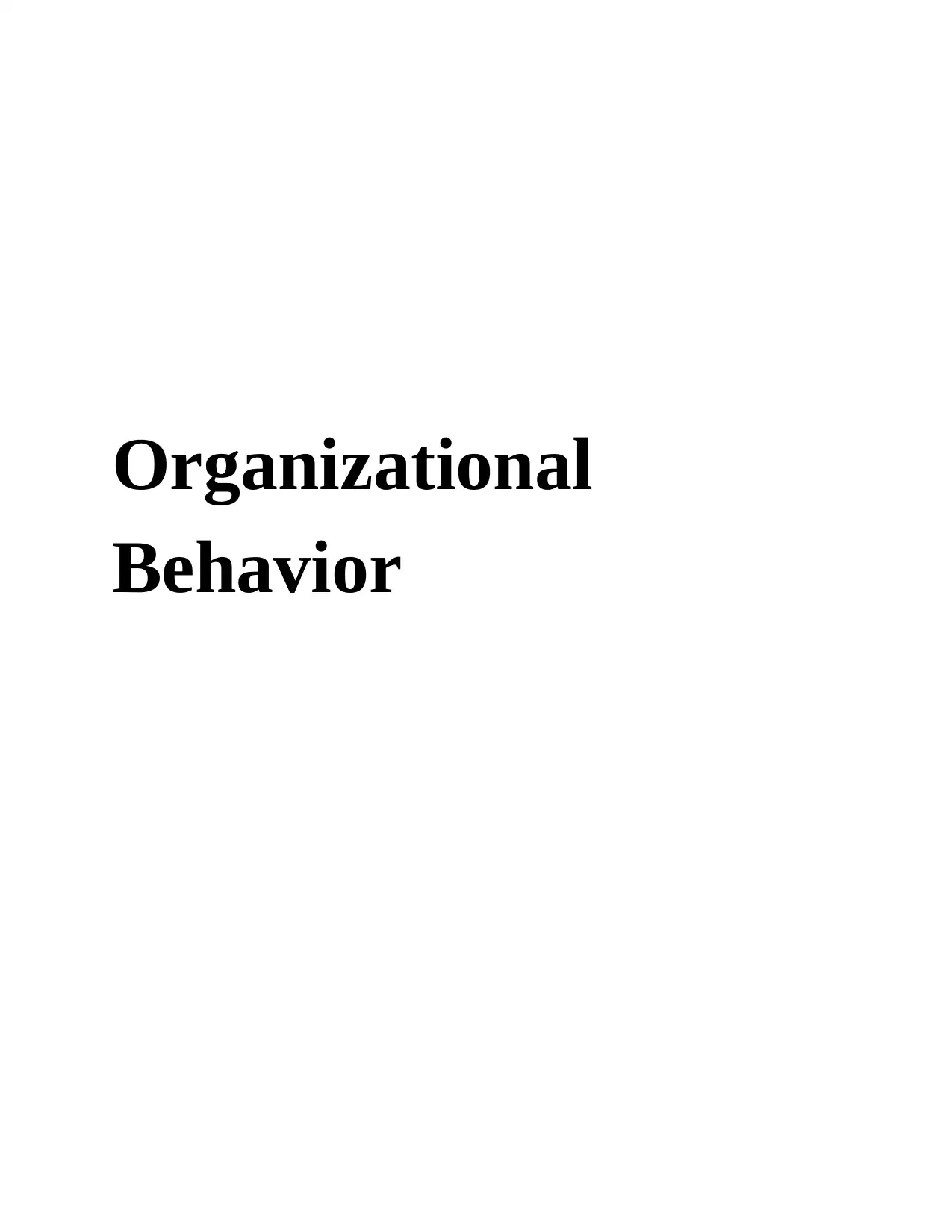
Organizational
Behavior
Behavior
Paraphrase This Document
Need a fresh take? Get an instant paraphrase of this document with our AI Paraphraser
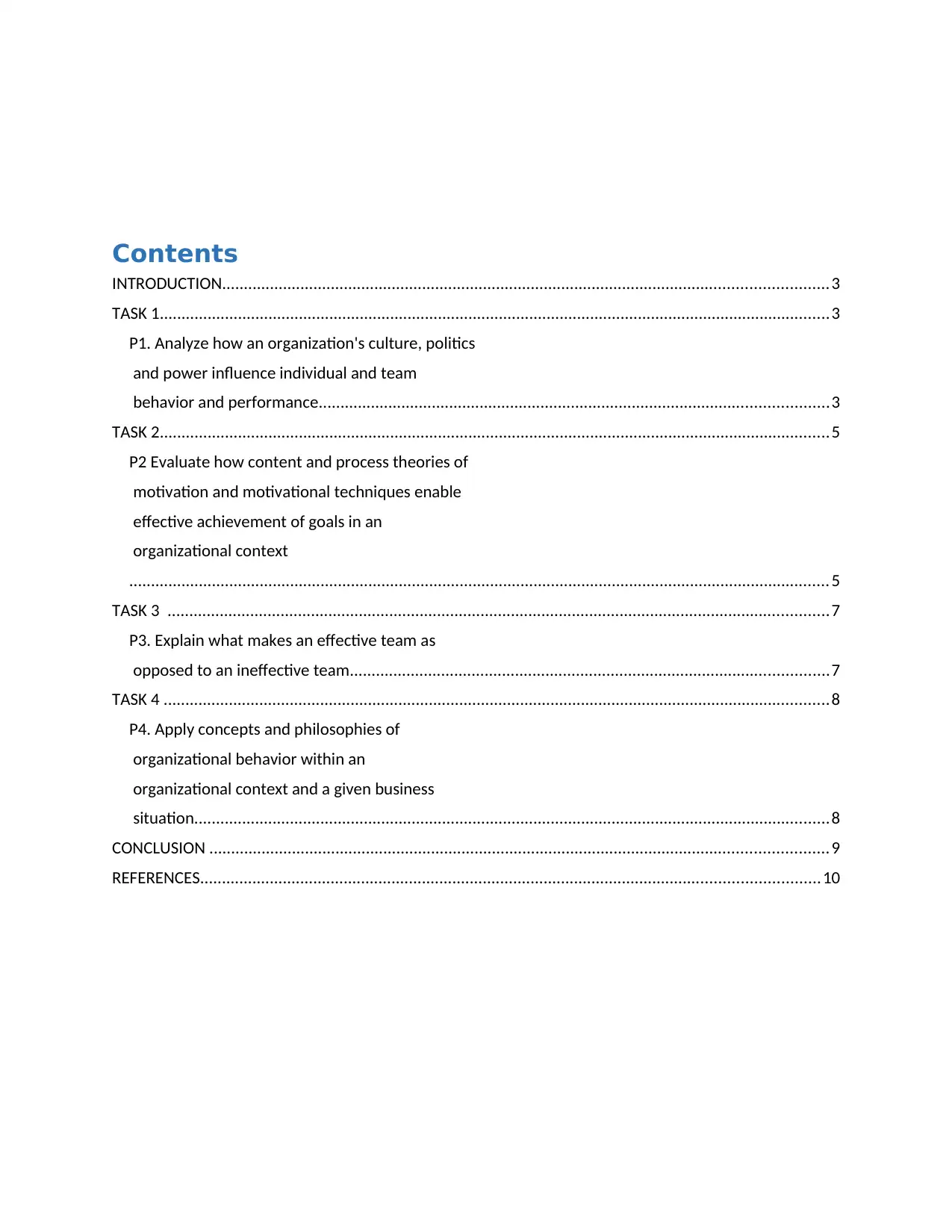
Contents
INTRODUCTION...........................................................................................................................................3
TASK 1..........................................................................................................................................................3
P1. Analyze how an organization's culture, politics
and power influence individual and team
behavior and performance.....................................................................................................................3
TASK 2..........................................................................................................................................................5
P2 Evaluate how content and process theories of
motivation and motivational techniques enable
effective achievement of goals in an
organizational context
.................................................................................................................................................................5
TASK 3 ........................................................................................................................................................7
P3. Explain what makes an effective team as
opposed to an ineffective team..............................................................................................................7
TASK 4 .........................................................................................................................................................8
P4. Apply concepts and philosophies of
organizational behavior within an
organizational context and a given business
situation..................................................................................................................................................8
CONCLUSION ..............................................................................................................................................9
REFERENCES..............................................................................................................................................10
INTRODUCTION...........................................................................................................................................3
TASK 1..........................................................................................................................................................3
P1. Analyze how an organization's culture, politics
and power influence individual and team
behavior and performance.....................................................................................................................3
TASK 2..........................................................................................................................................................5
P2 Evaluate how content and process theories of
motivation and motivational techniques enable
effective achievement of goals in an
organizational context
.................................................................................................................................................................5
TASK 3 ........................................................................................................................................................7
P3. Explain what makes an effective team as
opposed to an ineffective team..............................................................................................................7
TASK 4 .........................................................................................................................................................8
P4. Apply concepts and philosophies of
organizational behavior within an
organizational context and a given business
situation..................................................................................................................................................8
CONCLUSION ..............................................................................................................................................9
REFERENCES..............................................................................................................................................10
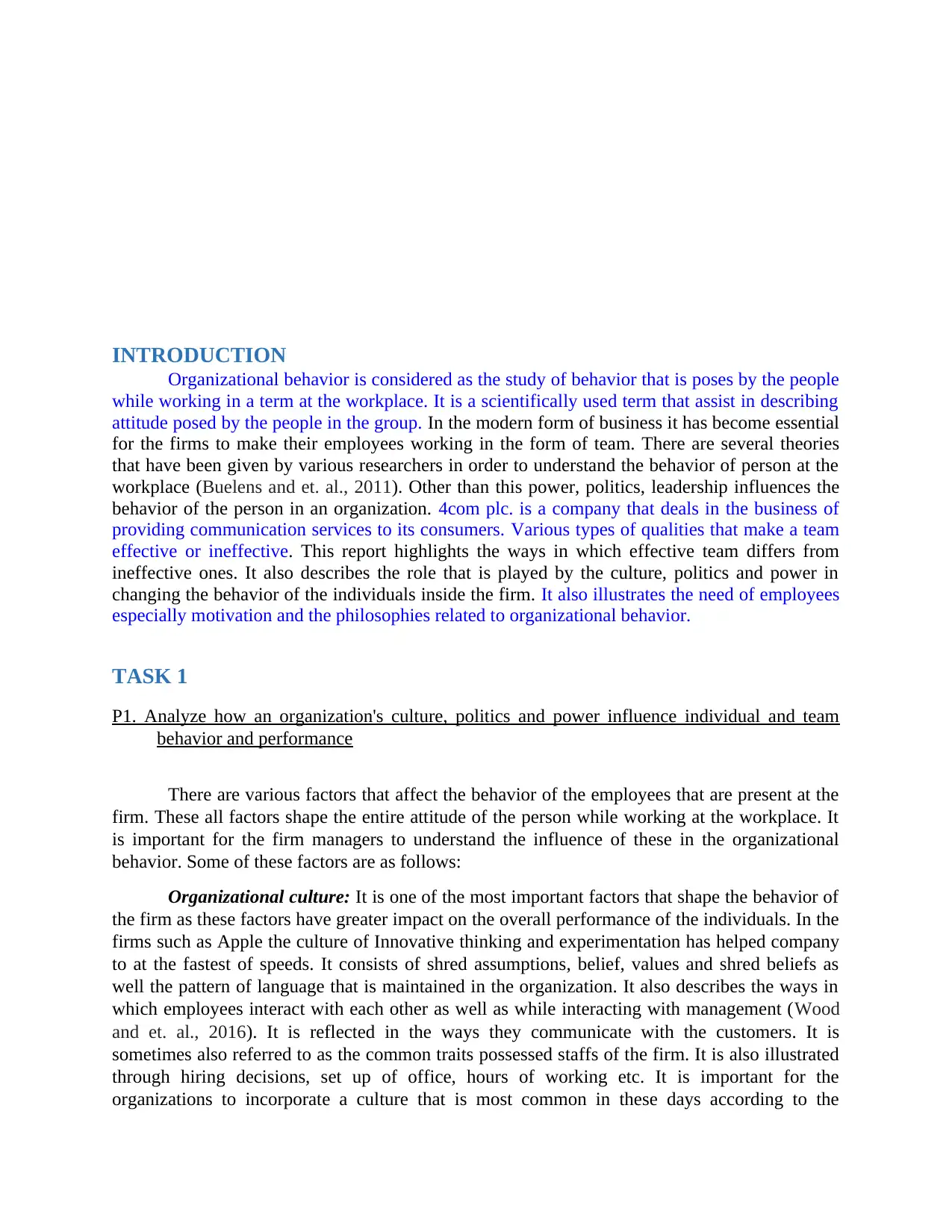
INTRODUCTION
Organizational behavior is considered as the study of behavior that is poses by the people
while working in a term at the workplace. It is a scientifically used term that assist in describing
attitude posed by the people in the group. In the modern form of business it has become essential
for the firms to make their employees working in the form of team. There are several theories
that have been given by various researchers in order to understand the behavior of person at the
workplace (Buelens and et. al., 2011). Other than this power, politics, leadership influences the
behavior of the person in an organization. 4com plc. is a company that deals in the business of
providing communication services to its consumers. Various types of qualities that make a team
effective or ineffective. This report highlights the ways in which effective team differs from
ineffective ones. It also describes the role that is played by the culture, politics and power in
changing the behavior of the individuals inside the firm. It also illustrates the need of employees
especially motivation and the philosophies related to organizational behavior.
TASK 1
P1. Analyze how an organization's culture, politics and power influence individual and team
behavior and performance
There are various factors that affect the behavior of the employees that are present at the
firm. These all factors shape the entire attitude of the person while working at the workplace. It
is important for the firm managers to understand the influence of these in the organizational
behavior. Some of these factors are as follows:
Organizational culture: It is one of the most important factors that shape the behavior of
the firm as these factors have greater impact on the overall performance of the individuals. In the
firms such as Apple the culture of Innovative thinking and experimentation has helped company
to at the fastest of speeds. It consists of shred assumptions, belief, values and shred beliefs as
well the pattern of language that is maintained in the organization. It also describes the ways in
which employees interact with each other as well as while interacting with management (Wood
and et. al., 2016). It is reflected in the ways they communicate with the customers. It is
sometimes also referred to as the common traits possessed staffs of the firm. It is also illustrated
through hiring decisions, set up of office, hours of working etc. It is important for the
organizations to incorporate a culture that is most common in these days according to the
Organizational behavior is considered as the study of behavior that is poses by the people
while working in a term at the workplace. It is a scientifically used term that assist in describing
attitude posed by the people in the group. In the modern form of business it has become essential
for the firms to make their employees working in the form of team. There are several theories
that have been given by various researchers in order to understand the behavior of person at the
workplace (Buelens and et. al., 2011). Other than this power, politics, leadership influences the
behavior of the person in an organization. 4com plc. is a company that deals in the business of
providing communication services to its consumers. Various types of qualities that make a team
effective or ineffective. This report highlights the ways in which effective team differs from
ineffective ones. It also describes the role that is played by the culture, politics and power in
changing the behavior of the individuals inside the firm. It also illustrates the need of employees
especially motivation and the philosophies related to organizational behavior.
TASK 1
P1. Analyze how an organization's culture, politics and power influence individual and team
behavior and performance
There are various factors that affect the behavior of the employees that are present at the
firm. These all factors shape the entire attitude of the person while working at the workplace. It
is important for the firm managers to understand the influence of these in the organizational
behavior. Some of these factors are as follows:
Organizational culture: It is one of the most important factors that shape the behavior of
the firm as these factors have greater impact on the overall performance of the individuals. In the
firms such as Apple the culture of Innovative thinking and experimentation has helped company
to at the fastest of speeds. It consists of shred assumptions, belief, values and shred beliefs as
well the pattern of language that is maintained in the organization. It also describes the ways in
which employees interact with each other as well as while interacting with management (Wood
and et. al., 2016). It is reflected in the ways they communicate with the customers. It is
sometimes also referred to as the common traits possessed staffs of the firm. It is also illustrated
through hiring decisions, set up of office, hours of working etc. It is important for the
organizations to incorporate a culture that is most common in these days according to the
⊘ This is a preview!⊘
Do you want full access?
Subscribe today to unlock all pages.

Trusted by 1+ million students worldwide
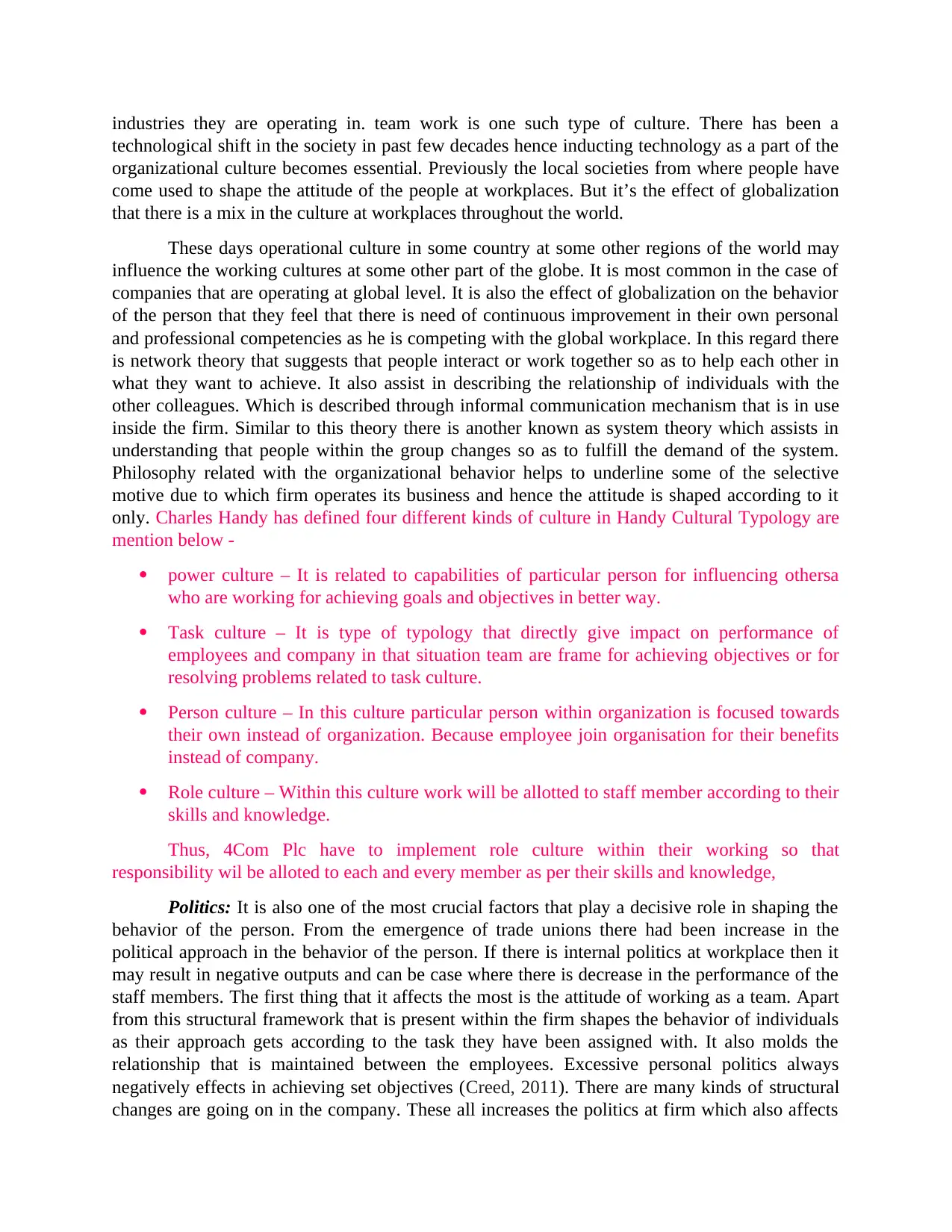
industries they are operating in. team work is one such type of culture. There has been a
technological shift in the society in past few decades hence inducting technology as a part of the
organizational culture becomes essential. Previously the local societies from where people have
come used to shape the attitude of the people at workplaces. But it’s the effect of globalization
that there is a mix in the culture at workplaces throughout the world.
These days operational culture in some country at some other regions of the world may
influence the working cultures at some other part of the globe. It is most common in the case of
companies that are operating at global level. It is also the effect of globalization on the behavior
of the person that they feel that there is need of continuous improvement in their own personal
and professional competencies as he is competing with the global workplace. In this regard there
is network theory that suggests that people interact or work together so as to help each other in
what they want to achieve. It also assist in describing the relationship of individuals with the
other colleagues. Which is described through informal communication mechanism that is in use
inside the firm. Similar to this theory there is another known as system theory which assists in
understanding that people within the group changes so as to fulfill the demand of the system.
Philosophy related with the organizational behavior helps to underline some of the selective
motive due to which firm operates its business and hence the attitude is shaped according to it
only. Charles Handy has defined four different kinds of culture in Handy Cultural Typology are
mention below -
power culture – It is related to capabilities of particular person for influencing othersa
who are working for achieving goals and objectives in better way.
Task culture – It is type of typology that directly give impact on performance of
employees and company in that situation team are frame for achieving objectives or for
resolving problems related to task culture.
Person culture – In this culture particular person within organization is focused towards
their own instead of organization. Because employee join organisation for their benefits
instead of company.
Role culture – Within this culture work will be allotted to staff member according to their
skills and knowledge.
Thus, 4Com Plc have to implement role culture within their working so that
responsibility wil be alloted to each and every member as per their skills and knowledge,
Politics: It is also one of the most crucial factors that play a decisive role in shaping the
behavior of the person. From the emergence of trade unions there had been increase in the
political approach in the behavior of the person. If there is internal politics at workplace then it
may result in negative outputs and can be case where there is decrease in the performance of the
staff members. The first thing that it affects the most is the attitude of working as a team. Apart
from this structural framework that is present within the firm shapes the behavior of individuals
as their approach gets according to the task they have been assigned with. It also molds the
relationship that is maintained between the employees. Excessive personal politics always
negatively effects in achieving set objectives (Creed, 2011). There are many kinds of structural
changes are going on in the company. These all increases the politics at firm which also affects
technological shift in the society in past few decades hence inducting technology as a part of the
organizational culture becomes essential. Previously the local societies from where people have
come used to shape the attitude of the people at workplaces. But it’s the effect of globalization
that there is a mix in the culture at workplaces throughout the world.
These days operational culture in some country at some other regions of the world may
influence the working cultures at some other part of the globe. It is most common in the case of
companies that are operating at global level. It is also the effect of globalization on the behavior
of the person that they feel that there is need of continuous improvement in their own personal
and professional competencies as he is competing with the global workplace. In this regard there
is network theory that suggests that people interact or work together so as to help each other in
what they want to achieve. It also assist in describing the relationship of individuals with the
other colleagues. Which is described through informal communication mechanism that is in use
inside the firm. Similar to this theory there is another known as system theory which assists in
understanding that people within the group changes so as to fulfill the demand of the system.
Philosophy related with the organizational behavior helps to underline some of the selective
motive due to which firm operates its business and hence the attitude is shaped according to it
only. Charles Handy has defined four different kinds of culture in Handy Cultural Typology are
mention below -
power culture – It is related to capabilities of particular person for influencing othersa
who are working for achieving goals and objectives in better way.
Task culture – It is type of typology that directly give impact on performance of
employees and company in that situation team are frame for achieving objectives or for
resolving problems related to task culture.
Person culture – In this culture particular person within organization is focused towards
their own instead of organization. Because employee join organisation for their benefits
instead of company.
Role culture – Within this culture work will be allotted to staff member according to their
skills and knowledge.
Thus, 4Com Plc have to implement role culture within their working so that
responsibility wil be alloted to each and every member as per their skills and knowledge,
Politics: It is also one of the most crucial factors that play a decisive role in shaping the
behavior of the person. From the emergence of trade unions there had been increase in the
political approach in the behavior of the person. If there is internal politics at workplace then it
may result in negative outputs and can be case where there is decrease in the performance of the
staff members. The first thing that it affects the most is the attitude of working as a team. Apart
from this structural framework that is present within the firm shapes the behavior of individuals
as their approach gets according to the task they have been assigned with. It also molds the
relationship that is maintained between the employees. Excessive personal politics always
negatively effects in achieving set objectives (Creed, 2011). There are many kinds of structural
changes are going on in the company. These all increases the politics at firm which also affects
Paraphrase This Document
Need a fresh take? Get an instant paraphrase of this document with our AI Paraphraser

the attitude of the employees. Hence alterations must be based on requirement of the firm. Politic
factor is that which directly impact performance of employees. Political factors affect working
environment of 4Com Plc. Because it result in minimizing effectiveness. Along with this,
political factor impact on the behavior of employees explanation are as follows :-
Maintain decorum – It is essential for company to maintain decorum in effective way so
that personal or team will perform their activities within effective manner. Such practices
will result in accomplishing goals and objectives.
Minimizing productivity – political factor will result in decreasing productivity of
individual and team. Because it will result in less attention towards task instead of other
factors.
Power: It is influencing aspect that is posed by the company as well as the people present
at the firm. The distribution of the powers must be done in a proper manner so that everyone can
understand their importance at the workforce. In most of the firms at present times power
distribution is uneven as it lies in the hands of one or two officials at the top of the organizational
structure. These powers present with the employees helps to determine the shape of the behavior
that is posed by the employees. It is the fact that power needs to be accompanied with
responsibility (Butler and Rose, 2011). More the power more should be the responsible behavior
that must be present. Here they need to be monitored every time. The position they handle brings
the power to them. The only power that remains with the workers that they could choose the
methods that they would follow in any specific situation. There are different type of power which
can influence behavior explanation of these are as follows :- Coercive power - It is related to the coercion which means that individual is forced by
superiors within organization for performing their task.
Reward power – In this power work will be assigned to individual members in exchange
of any rewards.
All these elements shape the overall levels of performance of the staffs as they directly
effects on the behavior of the person.
TASK 2
P2 Content and process theories of motivation and motivational techniques enable effective
achievement of goals in an organizational context
There are several types of theories of motivation which is provided by different
researchers all over the world. These theories have closer relation with the employee
performance. There are two types of motivational theories that are present namely process and
content theories. It is the role of the leaders to increase the levels of motivation in the employees
that too at regular intervals. It helps them to perform in a better way. Motivation flares the fire of
factor is that which directly impact performance of employees. Political factors affect working
environment of 4Com Plc. Because it result in minimizing effectiveness. Along with this,
political factor impact on the behavior of employees explanation are as follows :-
Maintain decorum – It is essential for company to maintain decorum in effective way so
that personal or team will perform their activities within effective manner. Such practices
will result in accomplishing goals and objectives.
Minimizing productivity – political factor will result in decreasing productivity of
individual and team. Because it will result in less attention towards task instead of other
factors.
Power: It is influencing aspect that is posed by the company as well as the people present
at the firm. The distribution of the powers must be done in a proper manner so that everyone can
understand their importance at the workforce. In most of the firms at present times power
distribution is uneven as it lies in the hands of one or two officials at the top of the organizational
structure. These powers present with the employees helps to determine the shape of the behavior
that is posed by the employees. It is the fact that power needs to be accompanied with
responsibility (Butler and Rose, 2011). More the power more should be the responsible behavior
that must be present. Here they need to be monitored every time. The position they handle brings
the power to them. The only power that remains with the workers that they could choose the
methods that they would follow in any specific situation. There are different type of power which
can influence behavior explanation of these are as follows :- Coercive power - It is related to the coercion which means that individual is forced by
superiors within organization for performing their task.
Reward power – In this power work will be assigned to individual members in exchange
of any rewards.
All these elements shape the overall levels of performance of the staffs as they directly
effects on the behavior of the person.
TASK 2
P2 Content and process theories of motivation and motivational techniques enable effective
achievement of goals in an organizational context
There are several types of theories of motivation which is provided by different
researchers all over the world. These theories have closer relation with the employee
performance. There are two types of motivational theories that are present namely process and
content theories. It is the role of the leaders to increase the levels of motivation in the employees
that too at regular intervals. It helps them to perform in a better way. Motivation flares the fire of
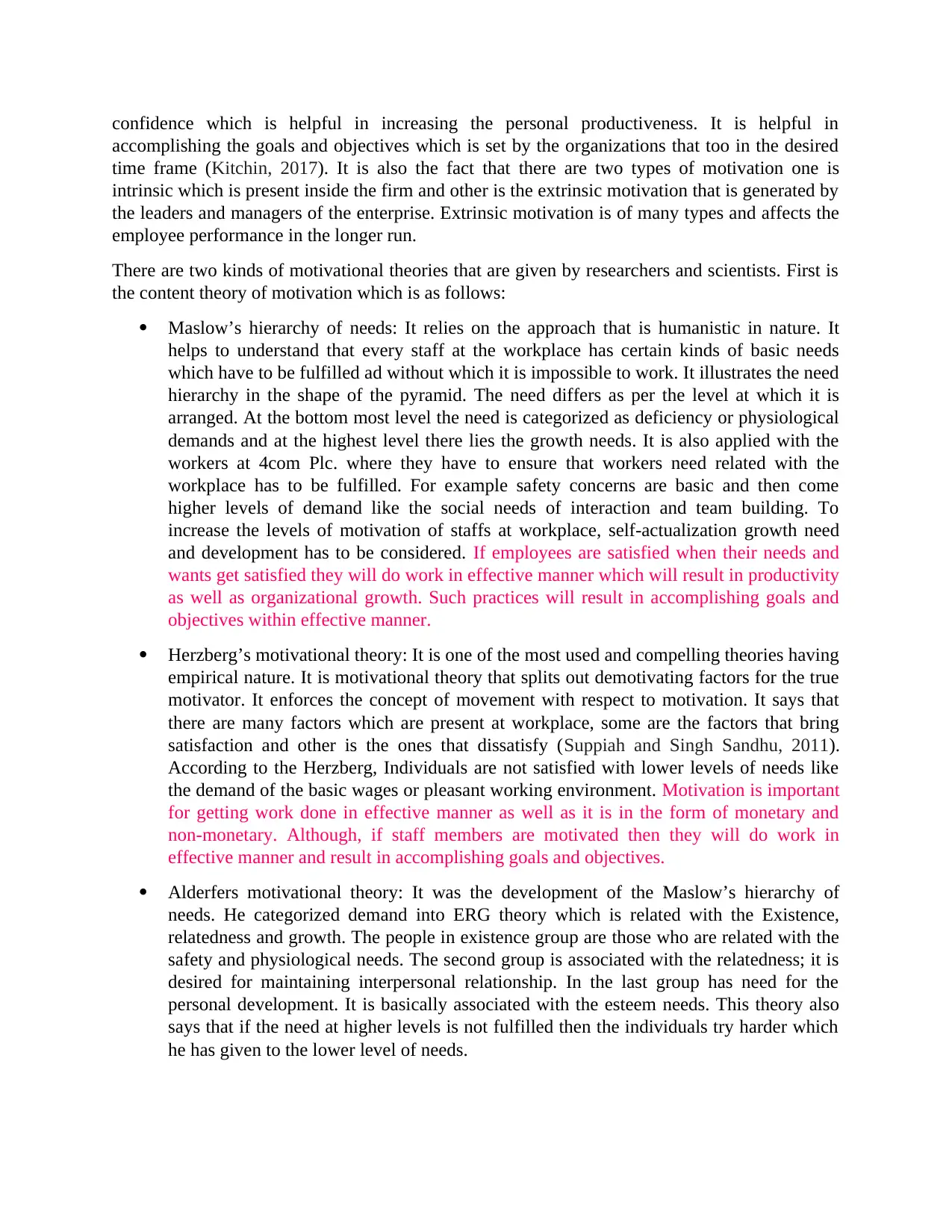
confidence which is helpful in increasing the personal productiveness. It is helpful in
accomplishing the goals and objectives which is set by the organizations that too in the desired
time frame (Kitchin, 2017). It is also the fact that there are two types of motivation one is
intrinsic which is present inside the firm and other is the extrinsic motivation that is generated by
the leaders and managers of the enterprise. Extrinsic motivation is of many types and affects the
employee performance in the longer run.
There are two kinds of motivational theories that are given by researchers and scientists. First is
the content theory of motivation which is as follows:
Maslow’s hierarchy of needs: It relies on the approach that is humanistic in nature. It
helps to understand that every staff at the workplace has certain kinds of basic needs
which have to be fulfilled ad without which it is impossible to work. It illustrates the need
hierarchy in the shape of the pyramid. The need differs as per the level at which it is
arranged. At the bottom most level the need is categorized as deficiency or physiological
demands and at the highest level there lies the growth needs. It is also applied with the
workers at 4com Plc. where they have to ensure that workers need related with the
workplace has to be fulfilled. For example safety concerns are basic and then come
higher levels of demand like the social needs of interaction and team building. To
increase the levels of motivation of staffs at workplace, self-actualization growth need
and development has to be considered. If employees are satisfied when their needs and
wants get satisfied they will do work in effective manner which will result in productivity
as well as organizational growth. Such practices will result in accomplishing goals and
objectives within effective manner.
Herzberg’s motivational theory: It is one of the most used and compelling theories having
empirical nature. It is motivational theory that splits out demotivating factors for the true
motivator. It enforces the concept of movement with respect to motivation. It says that
there are many factors which are present at workplace, some are the factors that bring
satisfaction and other is the ones that dissatisfy (Suppiah and Singh Sandhu, 2011).
According to the Herzberg, Individuals are not satisfied with lower levels of needs like
the demand of the basic wages or pleasant working environment. Motivation is important
for getting work done in effective manner as well as it is in the form of monetary and
non-monetary. Although, if staff members are motivated then they will do work in
effective manner and result in accomplishing goals and objectives.
Alderfers motivational theory: It was the development of the Maslow’s hierarchy of
needs. He categorized demand into ERG theory which is related with the Existence,
relatedness and growth. The people in existence group are those who are related with the
safety and physiological needs. The second group is associated with the relatedness; it is
desired for maintaining interpersonal relationship. In the last group has need for the
personal development. It is basically associated with the esteem needs. This theory also
says that if the need at higher levels is not fulfilled then the individuals try harder which
he has given to the lower level of needs.
accomplishing the goals and objectives which is set by the organizations that too in the desired
time frame (Kitchin, 2017). It is also the fact that there are two types of motivation one is
intrinsic which is present inside the firm and other is the extrinsic motivation that is generated by
the leaders and managers of the enterprise. Extrinsic motivation is of many types and affects the
employee performance in the longer run.
There are two kinds of motivational theories that are given by researchers and scientists. First is
the content theory of motivation which is as follows:
Maslow’s hierarchy of needs: It relies on the approach that is humanistic in nature. It
helps to understand that every staff at the workplace has certain kinds of basic needs
which have to be fulfilled ad without which it is impossible to work. It illustrates the need
hierarchy in the shape of the pyramid. The need differs as per the level at which it is
arranged. At the bottom most level the need is categorized as deficiency or physiological
demands and at the highest level there lies the growth needs. It is also applied with the
workers at 4com Plc. where they have to ensure that workers need related with the
workplace has to be fulfilled. For example safety concerns are basic and then come
higher levels of demand like the social needs of interaction and team building. To
increase the levels of motivation of staffs at workplace, self-actualization growth need
and development has to be considered. If employees are satisfied when their needs and
wants get satisfied they will do work in effective manner which will result in productivity
as well as organizational growth. Such practices will result in accomplishing goals and
objectives within effective manner.
Herzberg’s motivational theory: It is one of the most used and compelling theories having
empirical nature. It is motivational theory that splits out demotivating factors for the true
motivator. It enforces the concept of movement with respect to motivation. It says that
there are many factors which are present at workplace, some are the factors that bring
satisfaction and other is the ones that dissatisfy (Suppiah and Singh Sandhu, 2011).
According to the Herzberg, Individuals are not satisfied with lower levels of needs like
the demand of the basic wages or pleasant working environment. Motivation is important
for getting work done in effective manner as well as it is in the form of monetary and
non-monetary. Although, if staff members are motivated then they will do work in
effective manner and result in accomplishing goals and objectives.
Alderfers motivational theory: It was the development of the Maslow’s hierarchy of
needs. He categorized demand into ERG theory which is related with the Existence,
relatedness and growth. The people in existence group are those who are related with the
safety and physiological needs. The second group is associated with the relatedness; it is
desired for maintaining interpersonal relationship. In the last group has need for the
personal development. It is basically associated with the esteem needs. This theory also
says that if the need at higher levels is not fulfilled then the individuals try harder which
he has given to the lower level of needs.
⊘ This is a preview!⊘
Do you want full access?
Subscribe today to unlock all pages.

Trusted by 1+ million students worldwide
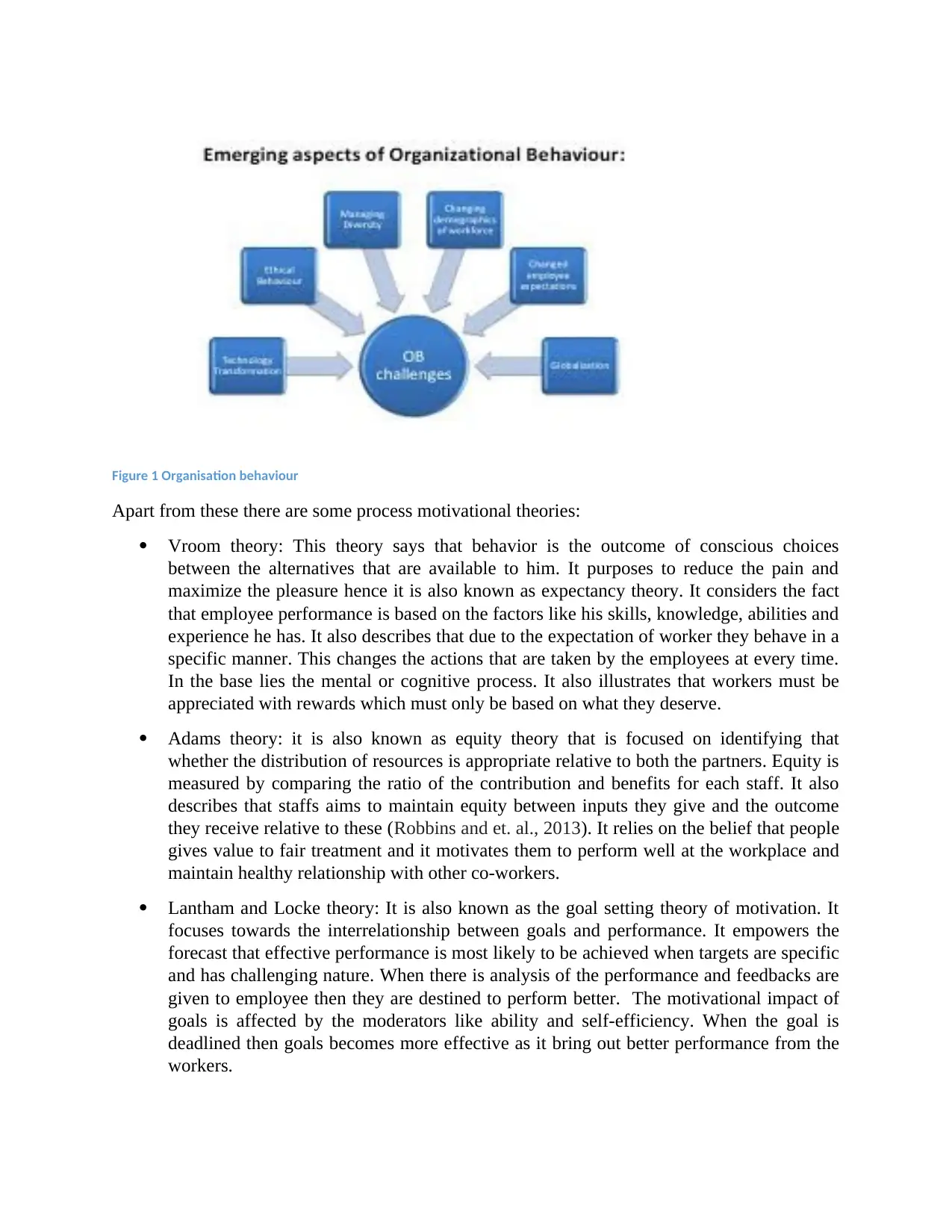
Figure 1 Organisation behaviour
Apart from these there are some process motivational theories:
Vroom theory: This theory says that behavior is the outcome of conscious choices
between the alternatives that are available to him. It purposes to reduce the pain and
maximize the pleasure hence it is also known as expectancy theory. It considers the fact
that employee performance is based on the factors like his skills, knowledge, abilities and
experience he has. It also describes that due to the expectation of worker they behave in a
specific manner. This changes the actions that are taken by the employees at every time.
In the base lies the mental or cognitive process. It also illustrates that workers must be
appreciated with rewards which must only be based on what they deserve.
Adams theory: it is also known as equity theory that is focused on identifying that
whether the distribution of resources is appropriate relative to both the partners. Equity is
measured by comparing the ratio of the contribution and benefits for each staff. It also
describes that staffs aims to maintain equity between inputs they give and the outcome
they receive relative to these (Robbins and et. al., 2013). It relies on the belief that people
gives value to fair treatment and it motivates them to perform well at the workplace and
maintain healthy relationship with other co-workers.
Lantham and Locke theory: It is also known as the goal setting theory of motivation. It
focuses towards the interrelationship between goals and performance. It empowers the
forecast that effective performance is most likely to be achieved when targets are specific
and has challenging nature. When there is analysis of the performance and feedbacks are
given to employee then they are destined to perform better. The motivational impact of
goals is affected by the moderators like ability and self-efficiency. When the goal is
deadlined then goals becomes more effective as it bring out better performance from the
workers.
Apart from these there are some process motivational theories:
Vroom theory: This theory says that behavior is the outcome of conscious choices
between the alternatives that are available to him. It purposes to reduce the pain and
maximize the pleasure hence it is also known as expectancy theory. It considers the fact
that employee performance is based on the factors like his skills, knowledge, abilities and
experience he has. It also describes that due to the expectation of worker they behave in a
specific manner. This changes the actions that are taken by the employees at every time.
In the base lies the mental or cognitive process. It also illustrates that workers must be
appreciated with rewards which must only be based on what they deserve.
Adams theory: it is also known as equity theory that is focused on identifying that
whether the distribution of resources is appropriate relative to both the partners. Equity is
measured by comparing the ratio of the contribution and benefits for each staff. It also
describes that staffs aims to maintain equity between inputs they give and the outcome
they receive relative to these (Robbins and et. al., 2013). It relies on the belief that people
gives value to fair treatment and it motivates them to perform well at the workplace and
maintain healthy relationship with other co-workers.
Lantham and Locke theory: It is also known as the goal setting theory of motivation. It
focuses towards the interrelationship between goals and performance. It empowers the
forecast that effective performance is most likely to be achieved when targets are specific
and has challenging nature. When there is analysis of the performance and feedbacks are
given to employee then they are destined to perform better. The motivational impact of
goals is affected by the moderators like ability and self-efficiency. When the goal is
deadlined then goals becomes more effective as it bring out better performance from the
workers.
Paraphrase This Document
Need a fresh take? Get an instant paraphrase of this document with our AI Paraphraser
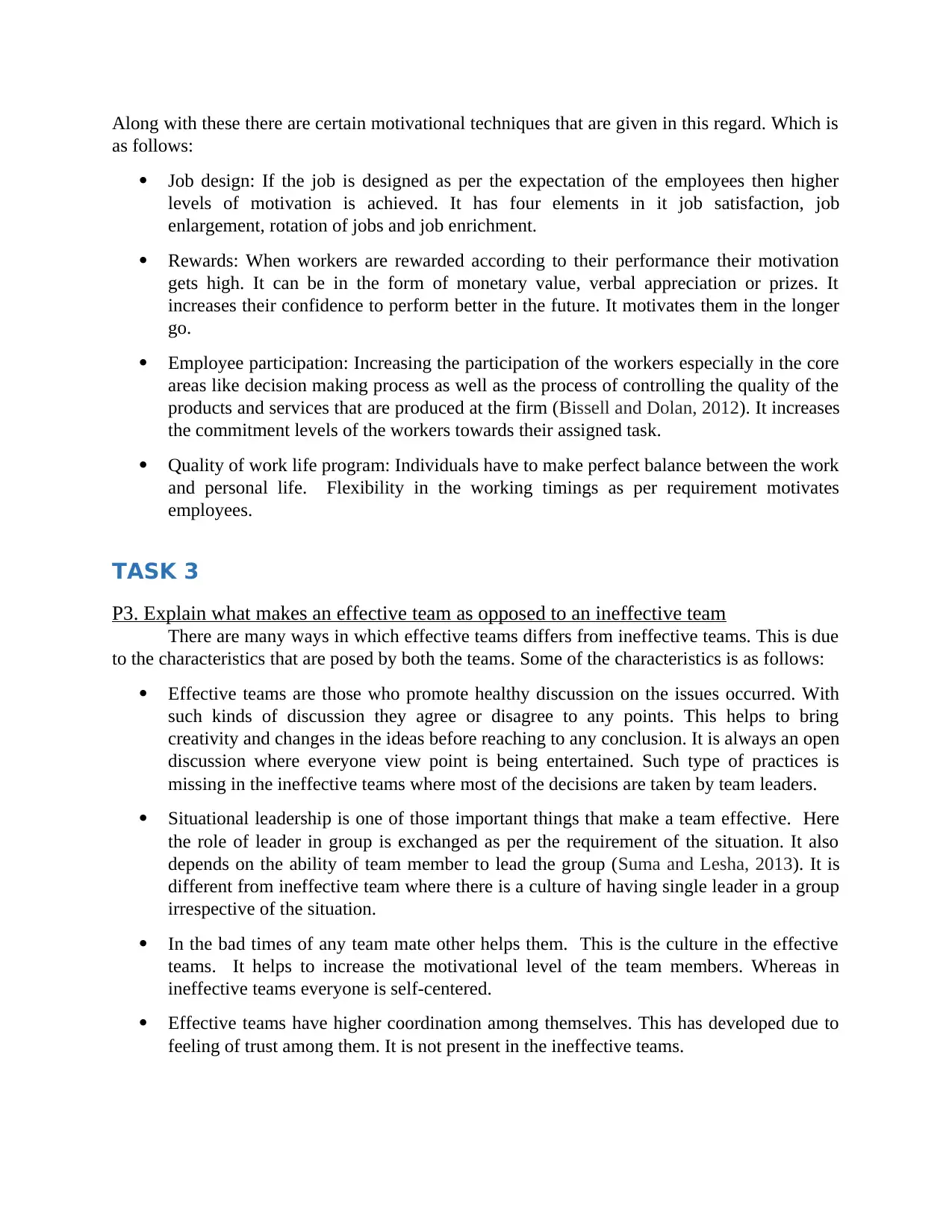
Along with these there are certain motivational techniques that are given in this regard. Which is
as follows:
Job design: If the job is designed as per the expectation of the employees then higher
levels of motivation is achieved. It has four elements in it job satisfaction, job
enlargement, rotation of jobs and job enrichment.
Rewards: When workers are rewarded according to their performance their motivation
gets high. It can be in the form of monetary value, verbal appreciation or prizes. It
increases their confidence to perform better in the future. It motivates them in the longer
go.
Employee participation: Increasing the participation of the workers especially in the core
areas like decision making process as well as the process of controlling the quality of the
products and services that are produced at the firm (Bissell and Dolan, 2012). It increases
the commitment levels of the workers towards their assigned task.
Quality of work life program: Individuals have to make perfect balance between the work
and personal life. Flexibility in the working timings as per requirement motivates
employees.
TASK 3
P3. Explain what makes an effective team as opposed to an ineffective team
There are many ways in which effective teams differs from ineffective teams. This is due
to the characteristics that are posed by both the teams. Some of the characteristics is as follows:
Effective teams are those who promote healthy discussion on the issues occurred. With
such kinds of discussion they agree or disagree to any points. This helps to bring
creativity and changes in the ideas before reaching to any conclusion. It is always an open
discussion where everyone view point is being entertained. Such type of practices is
missing in the ineffective teams where most of the decisions are taken by team leaders.
Situational leadership is one of those important things that make a team effective. Here
the role of leader in group is exchanged as per the requirement of the situation. It also
depends on the ability of team member to lead the group (Suma and Lesha, 2013). It is
different from ineffective team where there is a culture of having single leader in a group
irrespective of the situation.
In the bad times of any team mate other helps them. This is the culture in the effective
teams. It helps to increase the motivational level of the team members. Whereas in
ineffective teams everyone is self-centered.
Effective teams have higher coordination among themselves. This has developed due to
feeling of trust among them. It is not present in the ineffective teams.
as follows:
Job design: If the job is designed as per the expectation of the employees then higher
levels of motivation is achieved. It has four elements in it job satisfaction, job
enlargement, rotation of jobs and job enrichment.
Rewards: When workers are rewarded according to their performance their motivation
gets high. It can be in the form of monetary value, verbal appreciation or prizes. It
increases their confidence to perform better in the future. It motivates them in the longer
go.
Employee participation: Increasing the participation of the workers especially in the core
areas like decision making process as well as the process of controlling the quality of the
products and services that are produced at the firm (Bissell and Dolan, 2012). It increases
the commitment levels of the workers towards their assigned task.
Quality of work life program: Individuals have to make perfect balance between the work
and personal life. Flexibility in the working timings as per requirement motivates
employees.
TASK 3
P3. Explain what makes an effective team as opposed to an ineffective team
There are many ways in which effective teams differs from ineffective teams. This is due
to the characteristics that are posed by both the teams. Some of the characteristics is as follows:
Effective teams are those who promote healthy discussion on the issues occurred. With
such kinds of discussion they agree or disagree to any points. This helps to bring
creativity and changes in the ideas before reaching to any conclusion. It is always an open
discussion where everyone view point is being entertained. Such type of practices is
missing in the ineffective teams where most of the decisions are taken by team leaders.
Situational leadership is one of those important things that make a team effective. Here
the role of leader in group is exchanged as per the requirement of the situation. It also
depends on the ability of team member to lead the group (Suma and Lesha, 2013). It is
different from ineffective team where there is a culture of having single leader in a group
irrespective of the situation.
In the bad times of any team mate other helps them. This is the culture in the effective
teams. It helps to increase the motivational level of the team members. Whereas in
ineffective teams everyone is self-centered.
Effective teams have higher coordination among themselves. This has developed due to
feeling of trust among them. It is not present in the ineffective teams.
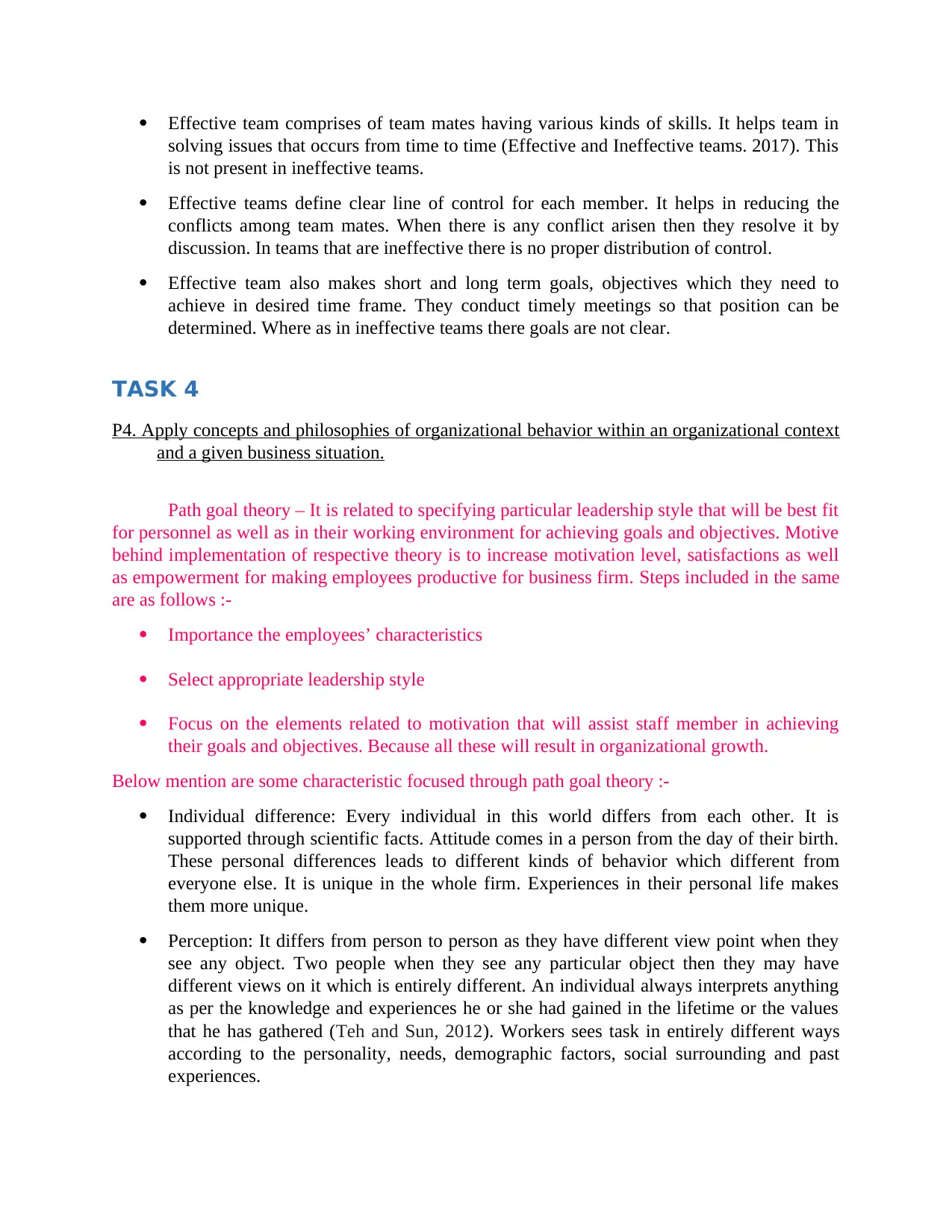
Effective team comprises of team mates having various kinds of skills. It helps team in
solving issues that occurs from time to time (Effective and Ineffective teams. 2017). This
is not present in ineffective teams.
Effective teams define clear line of control for each member. It helps in reducing the
conflicts among team mates. When there is any conflict arisen then they resolve it by
discussion. In teams that are ineffective there is no proper distribution of control.
Effective team also makes short and long term goals, objectives which they need to
achieve in desired time frame. They conduct timely meetings so that position can be
determined. Where as in ineffective teams there goals are not clear.
TASK 4
P4. Apply concepts and philosophies of organizational behavior within an organizational context
and a given business situation.
Path goal theory – It is related to specifying particular leadership style that will be best fit
for personnel as well as in their working environment for achieving goals and objectives. Motive
behind implementation of respective theory is to increase motivation level, satisfactions as well
as empowerment for making employees productive for business firm. Steps included in the same
are as follows :-
Importance the employees’ characteristics
Select appropriate leadership style
Focus on the elements related to motivation that will assist staff member in achieving
their goals and objectives. Because all these will result in organizational growth.
Below mention are some characteristic focused through path goal theory :-
Individual difference: Every individual in this world differs from each other. It is
supported through scientific facts. Attitude comes in a person from the day of their birth.
These personal differences leads to different kinds of behavior which different from
everyone else. It is unique in the whole firm. Experiences in their personal life makes
them more unique.
Perception: It differs from person to person as they have different view point when they
see any object. Two people when they see any particular object then they may have
different views on it which is entirely different. An individual always interprets anything
as per the knowledge and experiences he or she had gained in the lifetime or the values
that he has gathered (Teh and Sun, 2012). Workers sees task in entirely different ways
according to the personality, needs, demographic factors, social surrounding and past
experiences.
solving issues that occurs from time to time (Effective and Ineffective teams. 2017). This
is not present in ineffective teams.
Effective teams define clear line of control for each member. It helps in reducing the
conflicts among team mates. When there is any conflict arisen then they resolve it by
discussion. In teams that are ineffective there is no proper distribution of control.
Effective team also makes short and long term goals, objectives which they need to
achieve in desired time frame. They conduct timely meetings so that position can be
determined. Where as in ineffective teams there goals are not clear.
TASK 4
P4. Apply concepts and philosophies of organizational behavior within an organizational context
and a given business situation.
Path goal theory – It is related to specifying particular leadership style that will be best fit
for personnel as well as in their working environment for achieving goals and objectives. Motive
behind implementation of respective theory is to increase motivation level, satisfactions as well
as empowerment for making employees productive for business firm. Steps included in the same
are as follows :-
Importance the employees’ characteristics
Select appropriate leadership style
Focus on the elements related to motivation that will assist staff member in achieving
their goals and objectives. Because all these will result in organizational growth.
Below mention are some characteristic focused through path goal theory :-
Individual difference: Every individual in this world differs from each other. It is
supported through scientific facts. Attitude comes in a person from the day of their birth.
These personal differences leads to different kinds of behavior which different from
everyone else. It is unique in the whole firm. Experiences in their personal life makes
them more unique.
Perception: It differs from person to person as they have different view point when they
see any object. Two people when they see any particular object then they may have
different views on it which is entirely different. An individual always interprets anything
as per the knowledge and experiences he or she had gained in the lifetime or the values
that he has gathered (Teh and Sun, 2012). Workers sees task in entirely different ways
according to the personality, needs, demographic factors, social surrounding and past
experiences.
⊘ This is a preview!⊘
Do you want full access?
Subscribe today to unlock all pages.

Trusted by 1+ million students worldwide
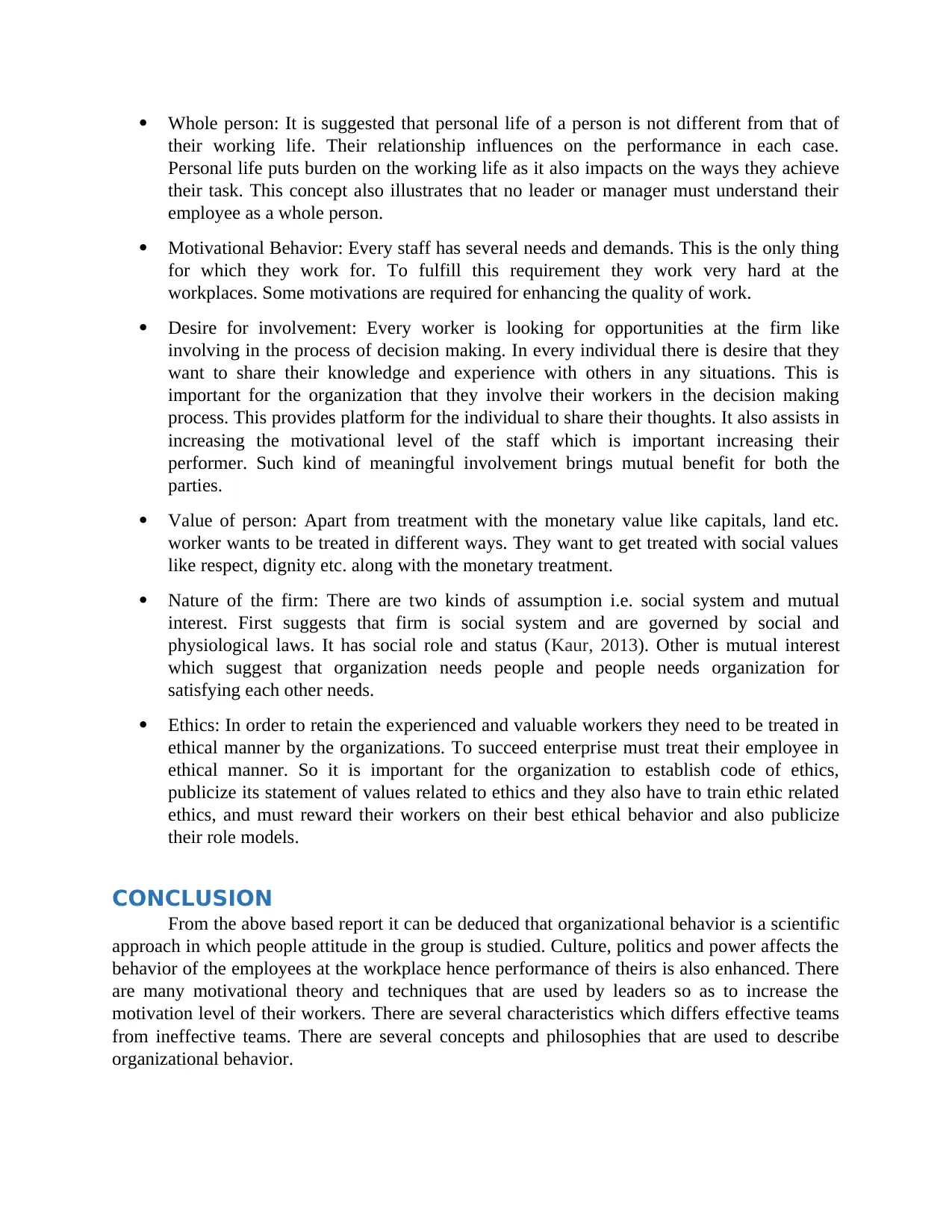
Whole person: It is suggested that personal life of a person is not different from that of
their working life. Their relationship influences on the performance in each case.
Personal life puts burden on the working life as it also impacts on the ways they achieve
their task. This concept also illustrates that no leader or manager must understand their
employee as a whole person.
Motivational Behavior: Every staff has several needs and demands. This is the only thing
for which they work for. To fulfill this requirement they work very hard at the
workplaces. Some motivations are required for enhancing the quality of work.
Desire for involvement: Every worker is looking for opportunities at the firm like
involving in the process of decision making. In every individual there is desire that they
want to share their knowledge and experience with others in any situations. This is
important for the organization that they involve their workers in the decision making
process. This provides platform for the individual to share their thoughts. It also assists in
increasing the motivational level of the staff which is important increasing their
performer. Such kind of meaningful involvement brings mutual benefit for both the
parties.
Value of person: Apart from treatment with the monetary value like capitals, land etc.
worker wants to be treated in different ways. They want to get treated with social values
like respect, dignity etc. along with the monetary treatment.
Nature of the firm: There are two kinds of assumption i.e. social system and mutual
interest. First suggests that firm is social system and are governed by social and
physiological laws. It has social role and status (Kaur, 2013). Other is mutual interest
which suggest that organization needs people and people needs organization for
satisfying each other needs.
Ethics: In order to retain the experienced and valuable workers they need to be treated in
ethical manner by the organizations. To succeed enterprise must treat their employee in
ethical manner. So it is important for the organization to establish code of ethics,
publicize its statement of values related to ethics and they also have to train ethic related
ethics, and must reward their workers on their best ethical behavior and also publicize
their role models.
CONCLUSION
From the above based report it can be deduced that organizational behavior is a scientific
approach in which people attitude in the group is studied. Culture, politics and power affects the
behavior of the employees at the workplace hence performance of theirs is also enhanced. There
are many motivational theory and techniques that are used by leaders so as to increase the
motivation level of their workers. There are several characteristics which differs effective teams
from ineffective teams. There are several concepts and philosophies that are used to describe
organizational behavior.
their working life. Their relationship influences on the performance in each case.
Personal life puts burden on the working life as it also impacts on the ways they achieve
their task. This concept also illustrates that no leader or manager must understand their
employee as a whole person.
Motivational Behavior: Every staff has several needs and demands. This is the only thing
for which they work for. To fulfill this requirement they work very hard at the
workplaces. Some motivations are required for enhancing the quality of work.
Desire for involvement: Every worker is looking for opportunities at the firm like
involving in the process of decision making. In every individual there is desire that they
want to share their knowledge and experience with others in any situations. This is
important for the organization that they involve their workers in the decision making
process. This provides platform for the individual to share their thoughts. It also assists in
increasing the motivational level of the staff which is important increasing their
performer. Such kind of meaningful involvement brings mutual benefit for both the
parties.
Value of person: Apart from treatment with the monetary value like capitals, land etc.
worker wants to be treated in different ways. They want to get treated with social values
like respect, dignity etc. along with the monetary treatment.
Nature of the firm: There are two kinds of assumption i.e. social system and mutual
interest. First suggests that firm is social system and are governed by social and
physiological laws. It has social role and status (Kaur, 2013). Other is mutual interest
which suggest that organization needs people and people needs organization for
satisfying each other needs.
Ethics: In order to retain the experienced and valuable workers they need to be treated in
ethical manner by the organizations. To succeed enterprise must treat their employee in
ethical manner. So it is important for the organization to establish code of ethics,
publicize its statement of values related to ethics and they also have to train ethic related
ethics, and must reward their workers on their best ethical behavior and also publicize
their role models.
CONCLUSION
From the above based report it can be deduced that organizational behavior is a scientific
approach in which people attitude in the group is studied. Culture, politics and power affects the
behavior of the employees at the workplace hence performance of theirs is also enhanced. There
are many motivational theory and techniques that are used by leaders so as to increase the
motivation level of their workers. There are several characteristics which differs effective teams
from ineffective teams. There are several concepts and philosophies that are used to describe
organizational behavior.
Paraphrase This Document
Need a fresh take? Get an instant paraphrase of this document with our AI Paraphraser
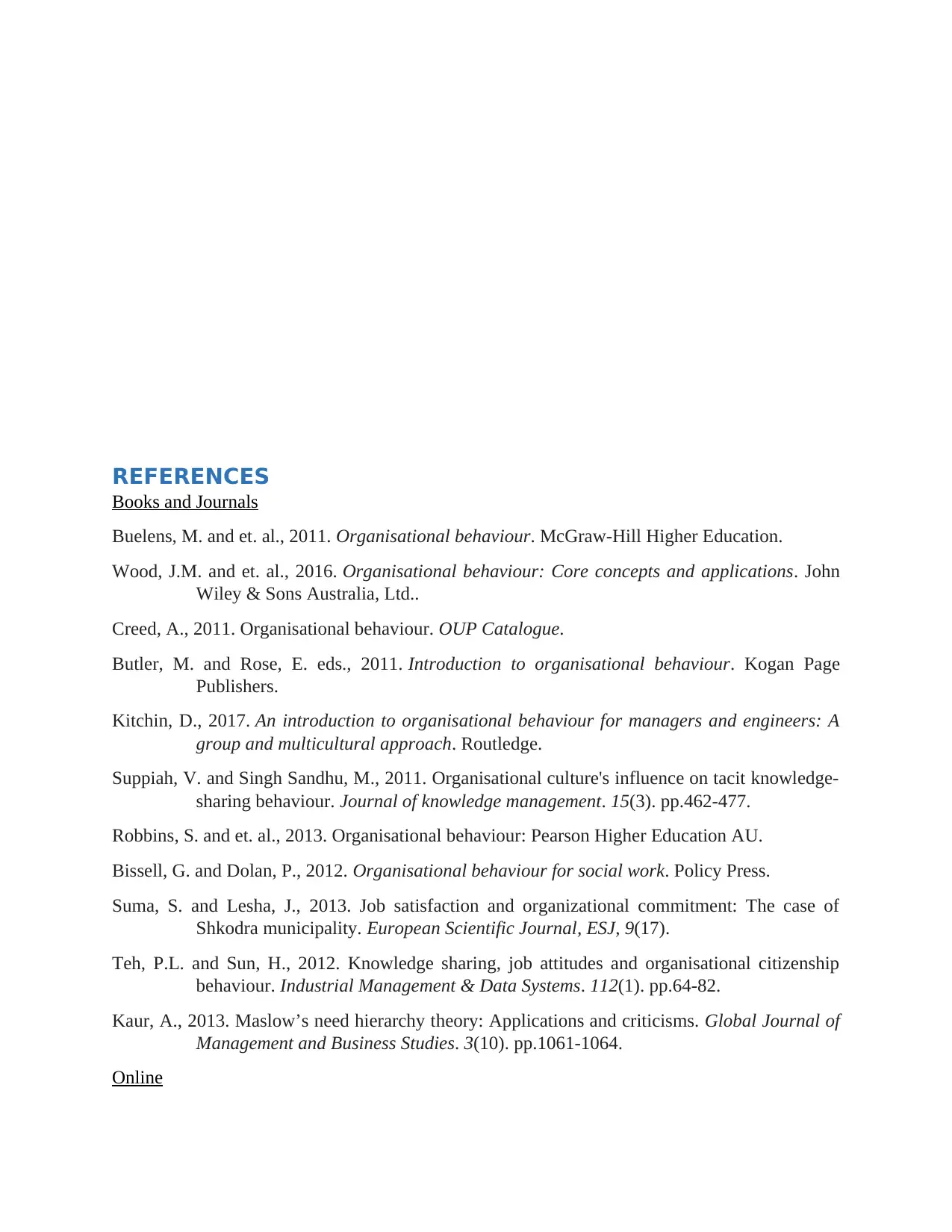
REFERENCES
Books and Journals
Buelens, M. and et. al., 2011. Organisational behaviour. McGraw-Hill Higher Education.
Wood, J.M. and et. al., 2016. Organisational behaviour: Core concepts and applications. John
Wiley & Sons Australia, Ltd..
Creed, A., 2011. Organisational behaviour. OUP Catalogue.
Butler, M. and Rose, E. eds., 2011. Introduction to organisational behaviour. Kogan Page
Publishers.
Kitchin, D., 2017. An introduction to organisational behaviour for managers and engineers: A
group and multicultural approach. Routledge.
Suppiah, V. and Singh Sandhu, M., 2011. Organisational culture's influence on tacit knowledge-
sharing behaviour. Journal of knowledge management. 15(3). pp.462-477.
Robbins, S. and et. al., 2013. Organisational behaviour: Pearson Higher Education AU.
Bissell, G. and Dolan, P., 2012. Organisational behaviour for social work. Policy Press.
Suma, S. and Lesha, J., 2013. Job satisfaction and organizational commitment: The case of
Shkodra municipality. European Scientific Journal, ESJ, 9(17).
Teh, P.L. and Sun, H., 2012. Knowledge sharing, job attitudes and organisational citizenship
behaviour. Industrial Management & Data Systems. 112(1). pp.64-82.
Kaur, A., 2013. Maslow’s need hierarchy theory: Applications and criticisms. Global Journal of
Management and Business Studies. 3(10). pp.1061-1064.
Online
Books and Journals
Buelens, M. and et. al., 2011. Organisational behaviour. McGraw-Hill Higher Education.
Wood, J.M. and et. al., 2016. Organisational behaviour: Core concepts and applications. John
Wiley & Sons Australia, Ltd..
Creed, A., 2011. Organisational behaviour. OUP Catalogue.
Butler, M. and Rose, E. eds., 2011. Introduction to organisational behaviour. Kogan Page
Publishers.
Kitchin, D., 2017. An introduction to organisational behaviour for managers and engineers: A
group and multicultural approach. Routledge.
Suppiah, V. and Singh Sandhu, M., 2011. Organisational culture's influence on tacit knowledge-
sharing behaviour. Journal of knowledge management. 15(3). pp.462-477.
Robbins, S. and et. al., 2013. Organisational behaviour: Pearson Higher Education AU.
Bissell, G. and Dolan, P., 2012. Organisational behaviour for social work. Policy Press.
Suma, S. and Lesha, J., 2013. Job satisfaction and organizational commitment: The case of
Shkodra municipality. European Scientific Journal, ESJ, 9(17).
Teh, P.L. and Sun, H., 2012. Knowledge sharing, job attitudes and organisational citizenship
behaviour. Industrial Management & Data Systems. 112(1). pp.64-82.
Kaur, A., 2013. Maslow’s need hierarchy theory: Applications and criticisms. Global Journal of
Management and Business Studies. 3(10). pp.1061-1064.
Online
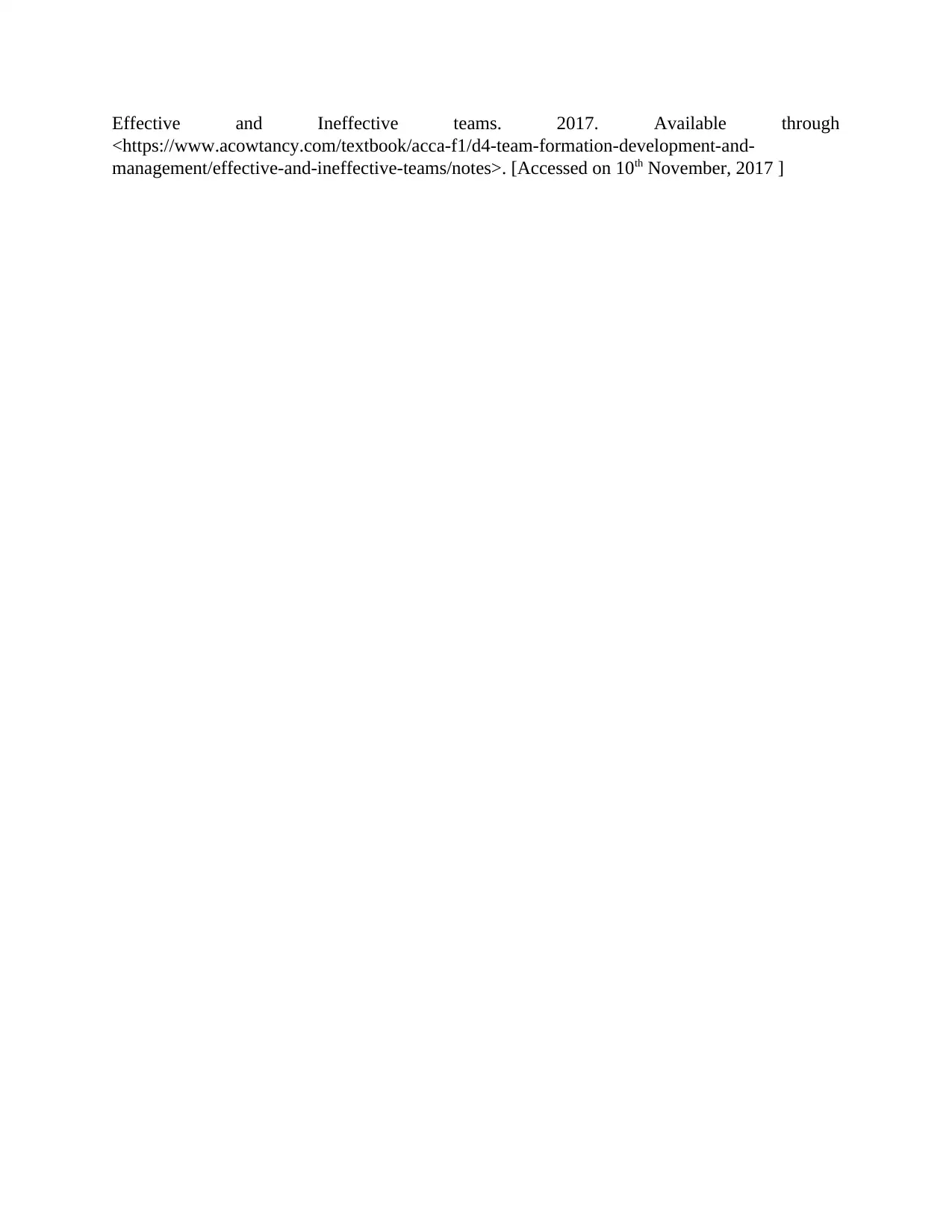
Effective and Ineffective teams. 2017. Available through
<https://www.acowtancy.com/textbook/acca-f1/d4-team-formation-development-and-
management/effective-and-ineffective-teams/notes>. [Accessed on 10th November, 2017 ]
<https://www.acowtancy.com/textbook/acca-f1/d4-team-formation-development-and-
management/effective-and-ineffective-teams/notes>. [Accessed on 10th November, 2017 ]
⊘ This is a preview!⊘
Do you want full access?
Subscribe today to unlock all pages.

Trusted by 1+ million students worldwide
1 out of 12
Related Documents
Your All-in-One AI-Powered Toolkit for Academic Success.
+13062052269
info@desklib.com
Available 24*7 on WhatsApp / Email
![[object Object]](/_next/static/media/star-bottom.7253800d.svg)
Unlock your academic potential
Copyright © 2020–2025 A2Z Services. All Rights Reserved. Developed and managed by ZUCOL.





